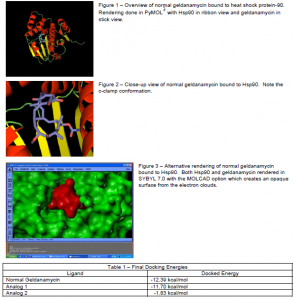Joshua Proulx and Dr. Merritt Andrus, Department of Chemistry and Biochemistry
For my project I simulated the binding of geldanamycin in the ATP binding site of Heat shock protein-90 to assist Merritt Andrus’s research in designing a better anti-cancer drug. Hsp-90 is a protein found in the cells of many organisms including humans. It functions as a chaperone protein, helping other proteins assume their proper folded shape. When a ligand like geldanamycin binds to the active site on Hsp-90, the protein’s function is inhibited. In many cancer cells Hsp-90 is folded into a 3D shape that allows for easy binding with geldanamycin. A cancerous cell with inhibited Hsp-90 is far more likely to die because some other proteins in the cell are unable to fold without Hsp-90. As a result, injecting geldanamycin into an organism near a tumor has been found to be an effective targeted anti-cancer treatment.
The scope of my research was to simulate the binding of Hsp-90 with different ligands: geldanamcyin and a few analogs, or variations of geldanamycin. Each analog of geldanamycin has the same basic molecular structure of geldanamycin with a few functional groups altered. The actual chemical structures of the analogs are withheld from this report to protect Dr. Andrus’s research and the ability to obtain patents in the future. In this report, I will simply refer to them as analog 1 and analog 2. After each docking simulation is run, I obtained a final docking energy which can then be compared between the structures to determine which compound the computer believes will be most favored for binding. The lower, more negative final docking energy is the favored compound.
To perform each simulation on the BYU supercomputer, the chemical structures of the protein and ligand were loaded from a PDB file. Next the ligand was extracted and modified and then a number of steps were done to prepare the files for simulation. The preparation steps were done with the SYBYL program1. Then I performed the docking calculations in SYBYL. The results I received did not appear to be valid. After a few weeks of struggling through SYBYL I found another widely used docking program called AutoDock2. The final results as seen in Table 1 were quite promising. While the first analog had a slightly higher docking energy, the difference was slight. If the simulations prove to be a valid estimate of the real binding potential, the first analog should be a good candidate for testing and will be a simpler compound to synthesize than normal geldanamycin. The second analog had a much higher docking energy and appeared to have difficultly fitting in the active site. Once the analogs are finally synthesized in Andrus’s lab, actual docking energies will be measured and compared to the simulated results. If the simulated energy values are close, many more analogs can be tested on the computer faster than the analog can be synthesized in real life, and the search can be focused even more to find an even better analog via the computer instead of just in the lab.
For the next stage of my research I am currently working on coding some scripts to perform the preparation steps for the docking simulations so that I can simulate thousands of analogs in a matter of days. Preparing the files by hand for each analog is extremely time-consuming and makes an exhaustive search for a better analog by hand nearly impossible. This next part of my research project is extremely exciting because the odds of finding an even better analog are increased with the ability to test numerous compounds without taking the time to create them in the lab.
References
- SYBYL 7.0, Tripos Inc., 1699 South Hanley Road, St. Louis, Missouri, 63144, USA.
- Morris, G. M., Goodsell, D. S., Halliday, R.S., Huey, R., Hart, W. E., Belew, R. K. and Olson, A. J. (1998), J. Computational Chemistry, 19: 1639-1662.
- DeLano, W.L. The PyMOL Molecular Graphics System (2002) DeLano Scientific, San Carlos, CA, USA.

